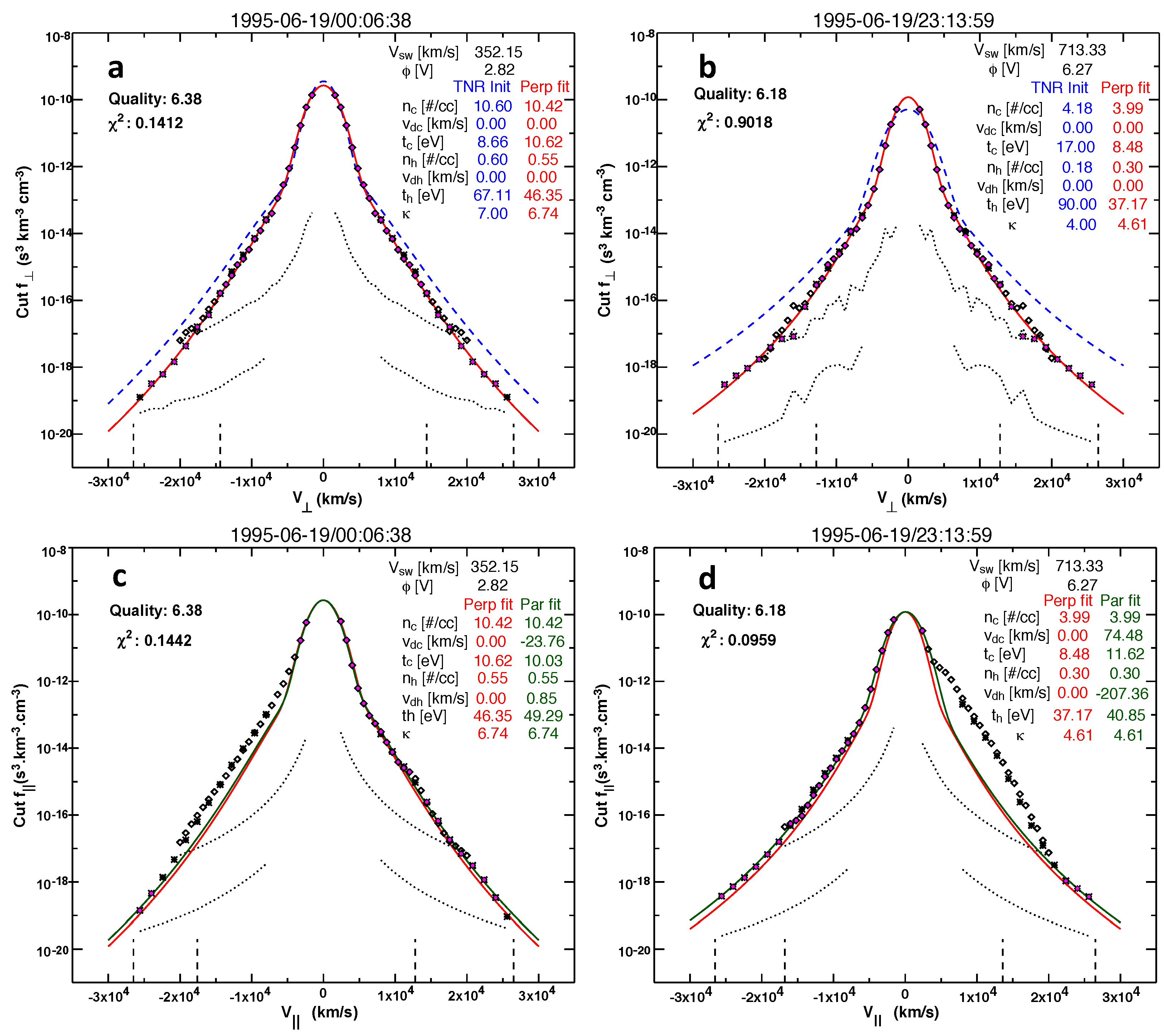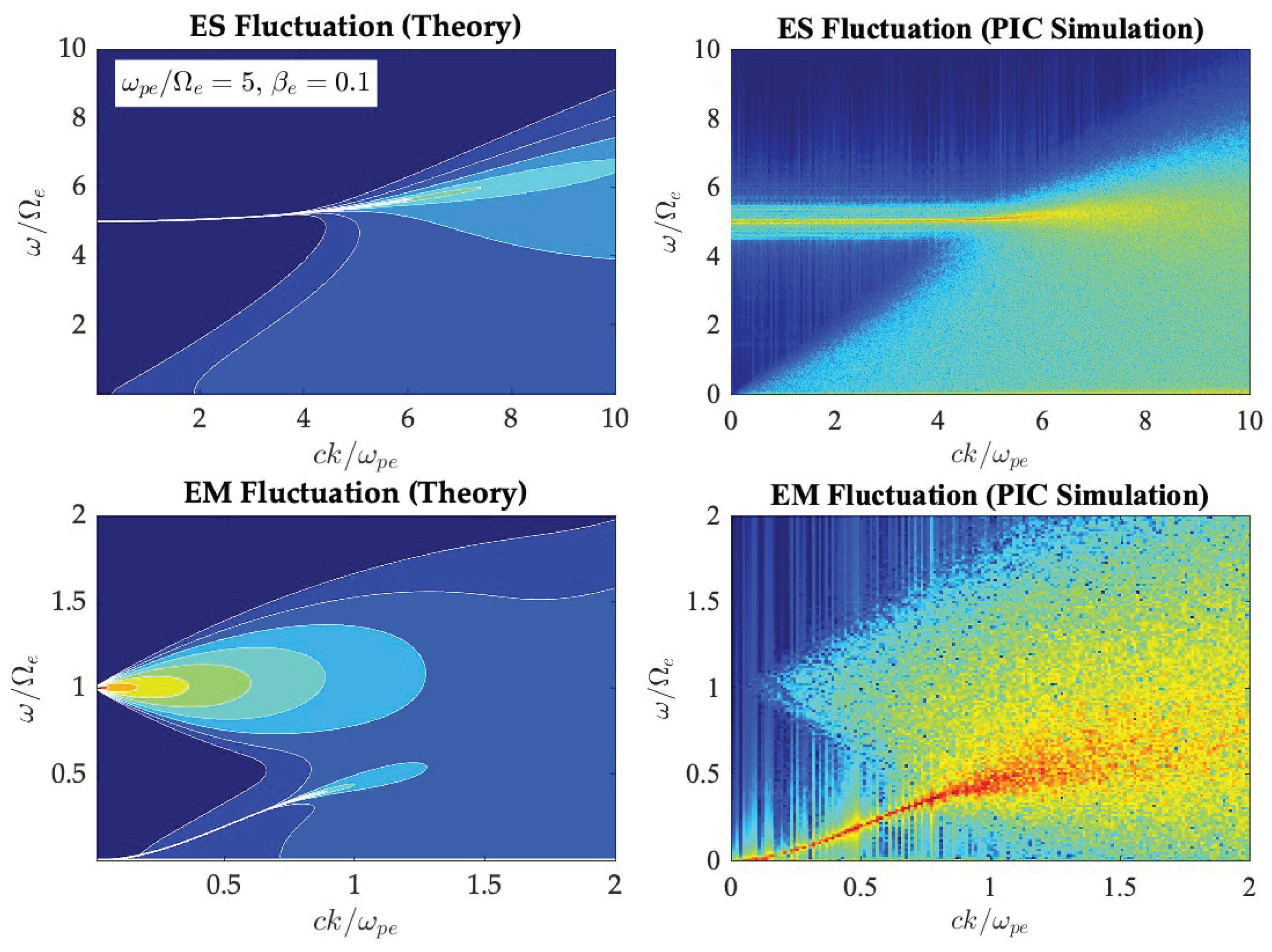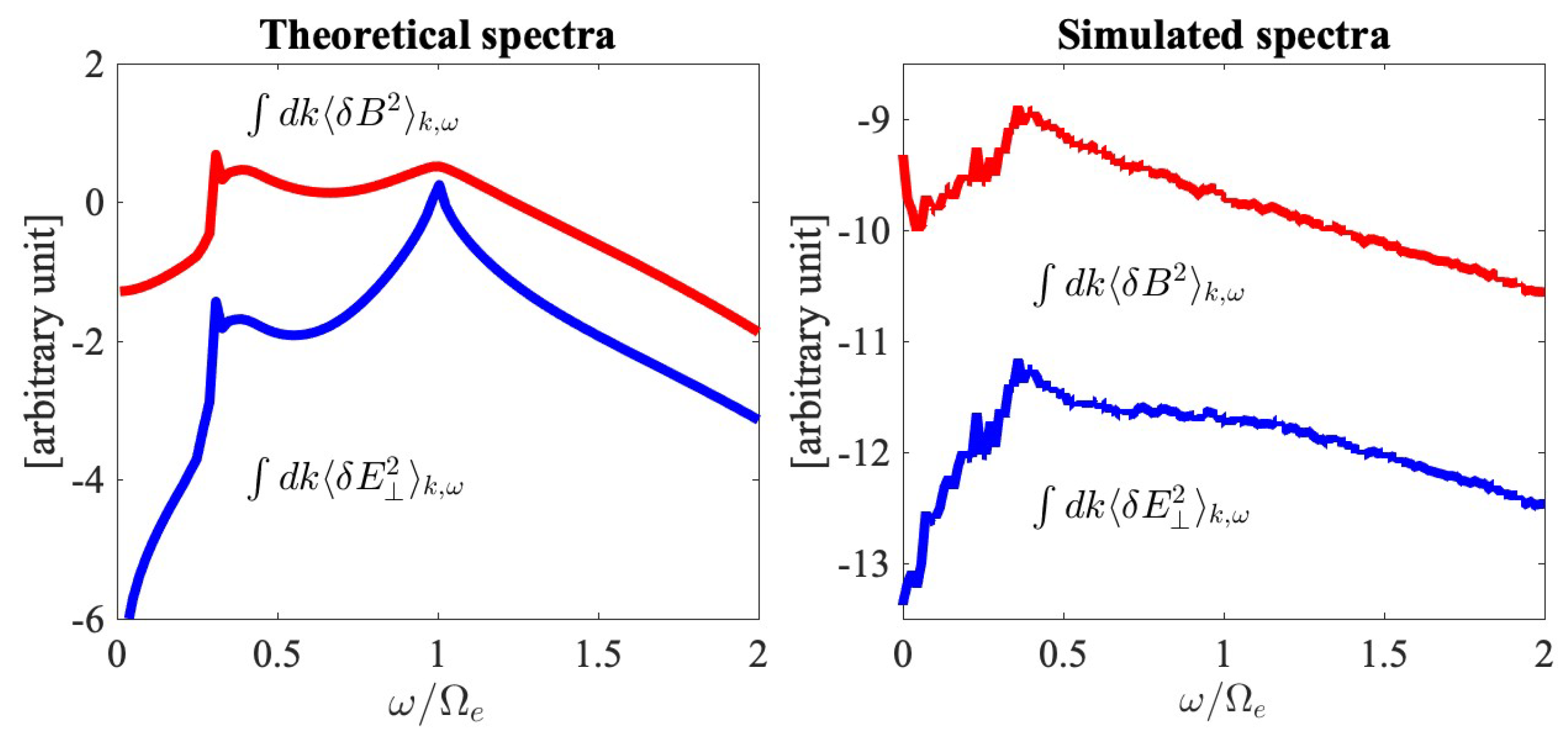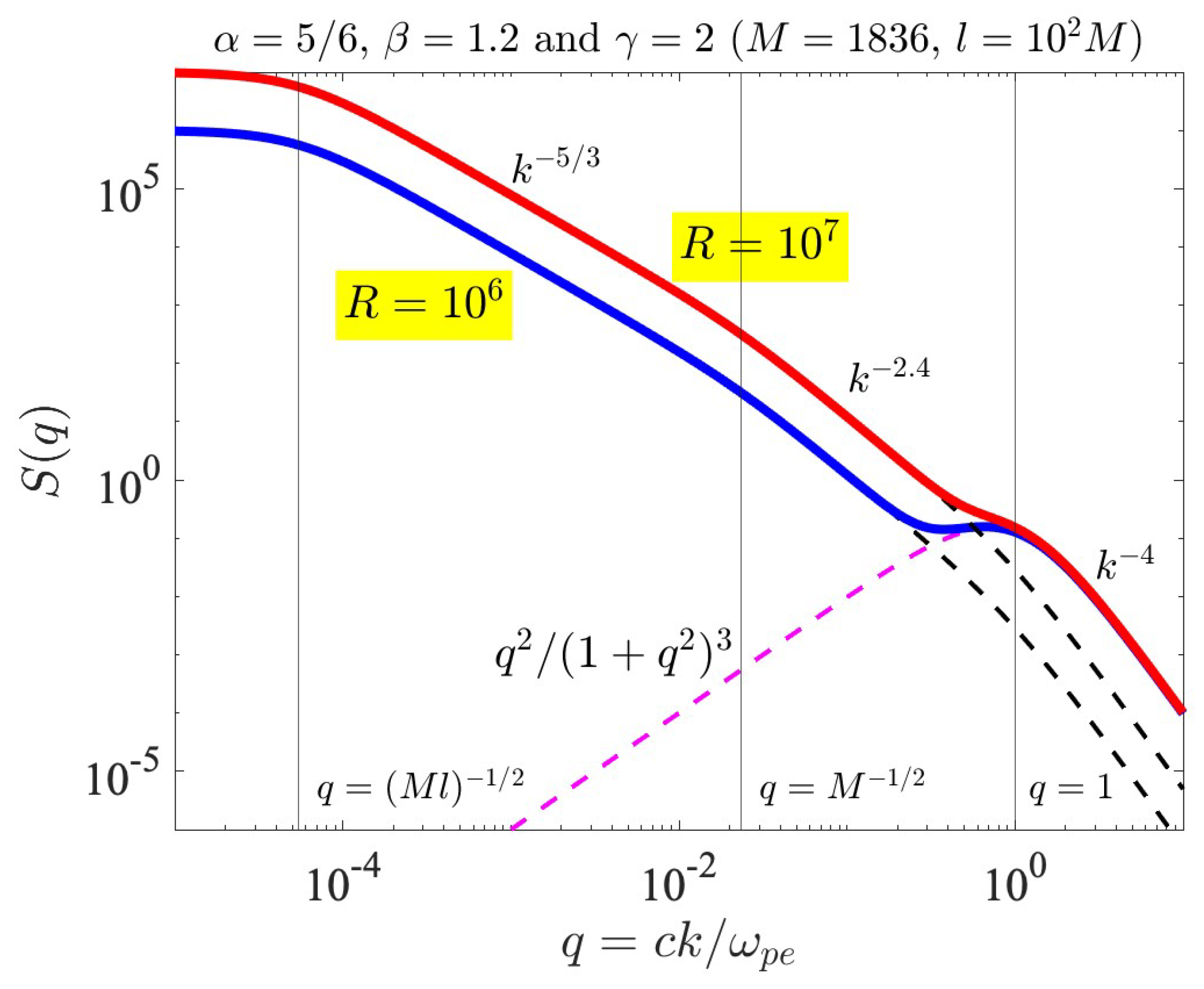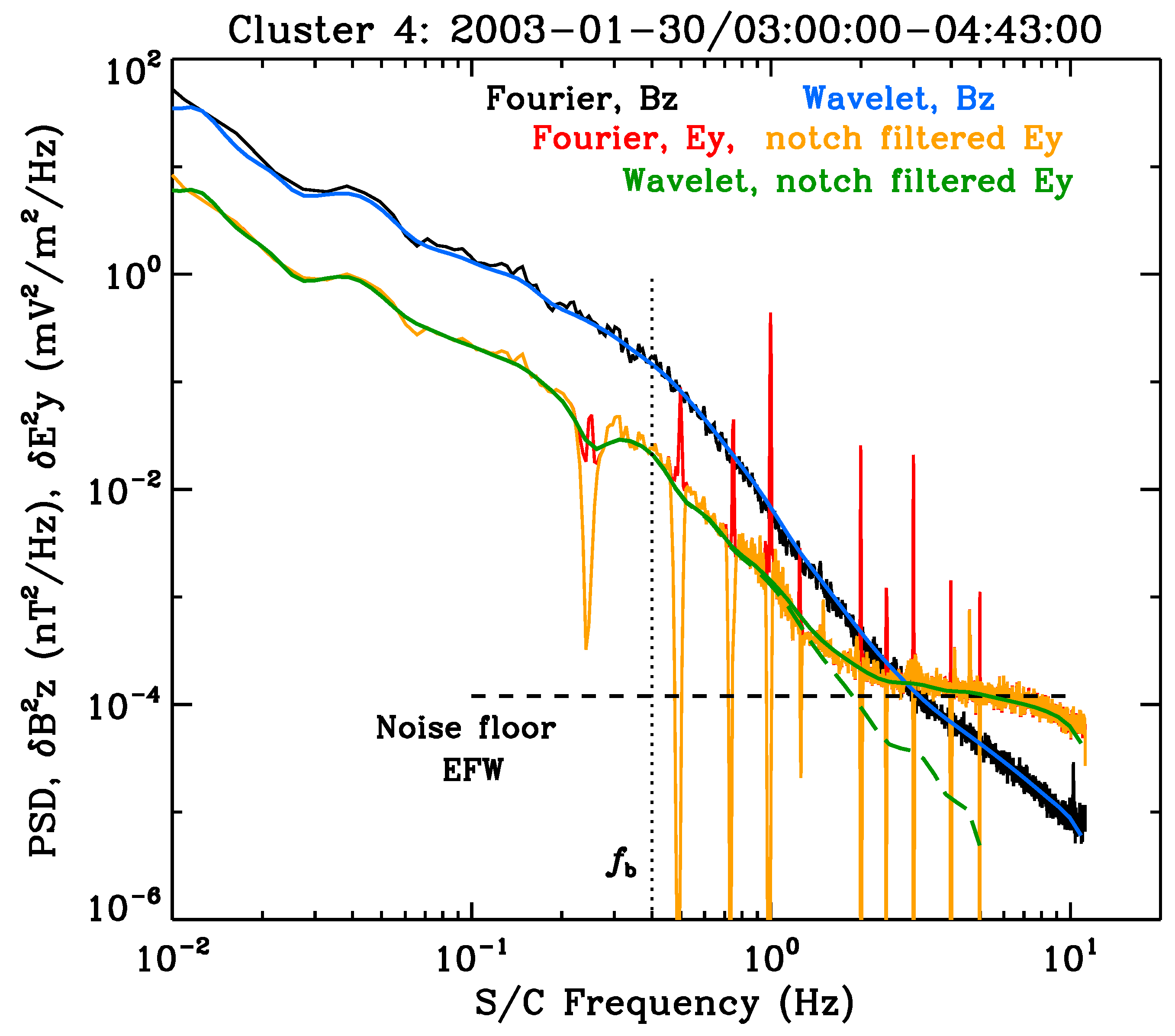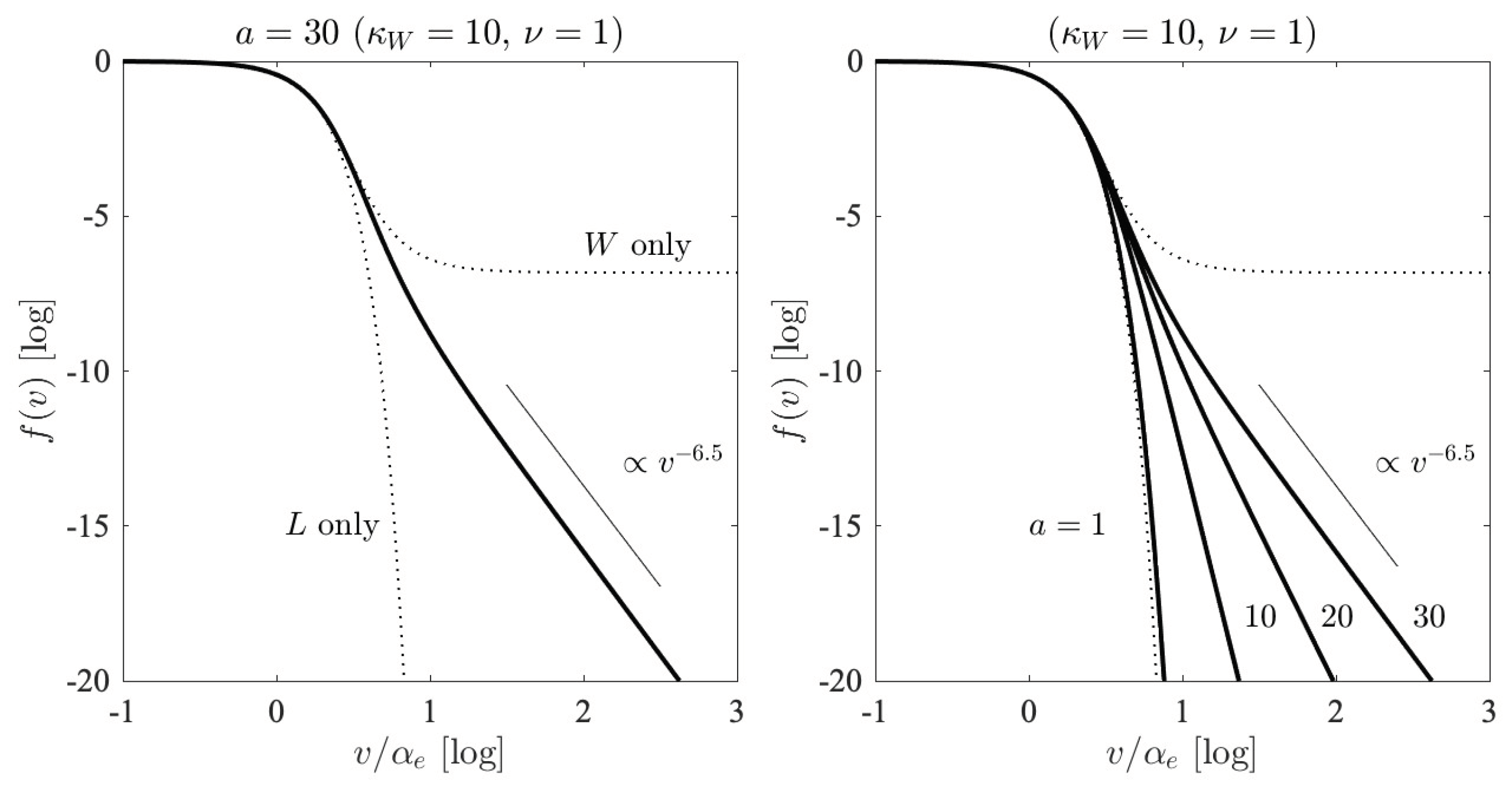1. Introduction
The in situ measurements of charged particles in the near-Earth space environment by artificial satellite became possible during the decade of 1960s. It was realized then that the velocity space distributions of charged particles that make up the space plasma deviate from the expected Maxwell-Boltzmann-Gauss statistics, but instead, the observed distributions typically feature a suprathermal (or non-thermal) component with an inverse power-law “tail” characteristics for suprathermal velocity regime,
for
, where
v represents the particle speed,
f is the charged particle velocity distribution function,
is the inverse power-law index, and
denotes the thermal speed [
1,
2,
3]. Recent inner heliospheric missions, Parker Solar Probe and Solar Orbiter, further confirm that such a non-thermal feature persists even for heliospheric environment much closer to the Sun [
4,
5,
6]. The physical origin of such a feature was not understood then. Instead, Olbert and Vasyliunas [
7,
8,
9,
10] introduced an empirical model known as the Kappa distribution,
to fit the observation. Here,
is the Maxwellian thermal speed, meaning that
is the thermal speed had
been given by the Maxwell-Boltzmann distribution,
is the Boltzmann constant, which can replaced by unity if we adopt the unit of eV for thermal energy. That is, if the temperature
T is expressed in eV instead of Kelvin (K), then we may take
. Hereafter, we shall adopt such a convention. The mass of the charged particles is denoted by
m. The free parameter
determines the degree to which the observed distribution deviates from the Maxwellian-Boltzmann (MB or thermal) distribution in that, if
then the model reduces to the thermal distribution,
, while for
, the Kappa model depicts an inverse power-law velocity distribution,
. It is to be noted that, regardless of the value of
index, the Kappa distribution approximates the MB distribution for
. That is, the Kappa model naturally encompasses the quasi Maxwellian feature in the “core” part of the velocity distribution characterized by
, and the inverse power-law tail portion of the distribution for the suprathermal regime,
.
A sample non-thermal charged-particle velocity distribution function in space is shown
Figure 1. Specifically,
Figure 1 plots the typical electron velocity distribution function measured in the near-Earth space environment during quiet-time condition.
Figure 1 is a reproduction of
Figure 4 of Ref. [
11], and it shows two typical electron velocity distribution functions (eVDFs) in the solar wind at 1 au (astronomical unit) measured by the Wind/3DP electrostatic analyzers EESA-L and EESA-H. The left panels (a) and (c) show an eVDF in the slow solar wind (at 1995-06-19/00:06:38), and the right panels (b) and (d) show an eVDF in the fast solar wind (at 1995-06-19/23:13:59). The top panels (a) and (b) show cuts through the eVDF in one of the two directions perpendicular to the local magnetic field
B: the diamonds are data points from EESA-L and the asterisks from EESA-H. The dotted lines represent the one-count level for EESA-L and EESA-H. The blue dashed line in
Figure 1a and b represents the sum of Maxwellian and Kappa distributions (indicated in blue). The red line represents the fit to the measured perpendicular eVDF cut; the resulting fit parameters are indicated in red. The bottom panels (c) and (d) show cuts through the eVDF in the direction parallel to
B. The perpendicular fit is shown in red, and the perpendicular fit parameters are used to initialize the parallel eVDF fit. For more details, see Ref. [
11] and
Figure 4 therewith, including the accompanying description.
It is well known that the MB distribution corresponds to the maximum entropic (or the most probable) state as defined through the textbook Boltzmann-Gibbs (BG) definition for the entropy [
12,
13,
14], namely,
, where
is the spatial integration normalized to the total volume,
, and
is the velocity distribution function. The Boltzmann-Gibbs (BG) entropy, which is additive and extensive, applies to an ideal gas or systems dictated by short-range interactions. The suitability of BG entropy for systems interacting through long-range forces, such as the plasma or gravitational systems, has been questioned since the inception of the BG entropy in the first place [
15,
16,
17]. The additive property relates to the BG entropy of a total system being equal to the entropies of subsystems. The extensivity means that the entropy is proportional to the total number of particles. The non-additive/non-extensive entropy, which presumably may be applicable to systems governed by long-range forces, violates these properties [
18]. The mathematical form of non-extensive entropy, which became well-known thanks to the work by Tsallis [
19], apparently were independently discovered several times over as entry 107 in Ref. [
18], p. 347, describes, but Tsallis’ model is most well known, and it has triggered an explosive growth of recent interest in the topic of non-extensive thermostatics, in the space plasma context as well as in other applications [
10,
20,
21]. The celebrated Tsallis entropy is defined by the form
, and the velocity distribution that corresponds to the maximum entropic (or the most probable) state is given by
Upon identifying
or alternatively
, one finds that the solution reduces to either
or
, respectively. Strictly speaking, neither is exactly identical to the Kappa distribution since
is defined with mixed
and
– see equation (
1). Nonetheless, this convergence of Tsallis’s non-extensive entropic principle and the Kappa model has led to the space physics community embracing the notion that the space plasma may be in a state of non-extensive statistical quasi-equilibrium [
10,
20,
22,
23,
24].
From the microscopic plasma physics, it is known that the electron Kappa distribution can be regarded as an end product of the weak electrostatic Langmuir turbulence [
25,
26]. The initial findings involved a numerical study of a gentle weak electron beam-plasma (or bump-on-tail) instability and subsequent saturation of the Langmuir turbulence. It was found that the quasi-steady state of the Langmuir turbulence is characterized by the formation of a non-thermal, Kappa-like velocity distribution function. Subsequently, more rigorous theoretical analysis revealed that the kappa distribution belongs to a family of unique solutions that characterize a steady-state electrostatic plasma turbulence [
27,
28]. This finding implies that a profound inter-relationship may exist between the non-extensive statistical state and the turbulent quasi-equilibrium, but the precise mathematical formulation to establish such a connection does not yet exist at present.
The findings in Refs. [
27,
28] directly relate to the solar wind electrons [
11,
29], which can be interpreted as velocity distribution functions made of multiple subcomponents. The primary component is the quasi-Maxwellian core population. The hotter and tenuous halo electron population can be distinguished from the core population by its distinct velocity profile, which can be modeled by an inverse power law. Other distinct populations can also be identified. For high-speed solar wind streams, highly field-aligned strahl component can be separately classified from the halo electrons by their narrow pitch-angle distribution. Also, the highly energetic superhalo electrons, that are observed in nearly all solar wind conditions, including the inner heliosphere [
4,
5] with nearly invariant velocity power law index, are also a distinct component [
29,
30,
31].
In the present paper, we will first briefly overview the previous weak turbulence theory of electron kappa distribution [
27], but thereafter, we will discuss a new development, which involves the whistler-mode fluctuations and turbulence. For the near-Earth space plasma environment as well as for the inner heliosphere close to the Sun, the effects of wave-particle resonant interaction that involves the whistler-mode waves, instability, and fluctuations on the electrons are important [
6,
32,
33,
34,
35]. As such, we consider the consequence of the electrons undergoing wave-particle resonant interactions with the background turbulence in the whistler-mode frequency range in the present paper. As it will be shown, the impact of such interactions is none other than the formation of a non-thermal, generalized Kappa velocity distribution function for the electrons. However, in the theoretical formalism of the present paper, it turns out that thermal fluctuations play an important role. A finite-temperature plasma constantly spontaneously emits and reabsorbs electromagnetic fluctuations – the fluctuation-dissipation theorem. A correct self-consistent theory of steady-state plasma particle velocity distribution based upon the steady-state Fokker-Planck particle kinetic equation thus requires the computation of thermal fluctuations. We thus begin the discourse by considering the thermal fluctuations emitted by the core electrons, and the modification of the fluctuation spectrum by the presence of background turbulence.
2. Thermal fluctuations emitted by Maxwellian core electrons in the background of solar wind turbulence
In this section, we discuss the quasi-steady-state spectrum of the electrostatic and electromagnetic fluctuations in the background of solar wind turbulence. We assume that the thermal fluctuations are spontaneously emitted and reabsorbed predominantly by the Maxwellian core electrons. The background large-amplitude turbulence is assumed to be of the transverse electromagnetic type, with its characteristic frequency that encompasses the whistler-mode frequency range. The combined fluctuations and turbulence spectra determine the quasi-steady-state velocity distribution function for the solar wind halo electrons. As already discussed, the solar wind electrons are observed to be made of several distinct components, but the simplest description pertains to the two-component model in which, these electrons comprise a dense Maxwellian core electrons and a tenuous but energetic halo electron population. It turns out that the halo electrons immersed in the field of thermal fluctuations alone will be organized in velocity space into a Maxwellian distribution. Thus, in this case, there will be no distinction between the core and halo so that both species will form one continuous thermal population. However, if there exist turbulent wave spectra for the whistler mode, then as the electrons interact with these combined spontaneously generated fluctuations and turbulence, they will organize into a non-thermal velocity distribution function, which manifests a clear demarcation between the core population and a tail component. The spontaneous emission is important because these background fluctuations provide the basis upon which non-thermal distribution can be built.
The electrostatic component of the spontaneous emission [
36,
37] is the well-known quasi-thermal noise [
38], but the solar wind core electrons should also emit electromagnetic emissions as well, although a clear identification of such a transverse quasi thermal noise is difficult because it will be partially occulted by the background turbulence. However, with improved future detection techniques, identifying the transverse quasi-thermal noise may become possible. Although we expect that the electric and magnetic fields associated with the whistler-mode fluctuations to partially overlap with the frequency range of the background solar wind turbulence, the spectrum should extend to slightly higher frequencies so that with sufficiently sensitive instruments, the identification could be possible. Even with today’s technology, if one analyzes the data with sufficient accuracy for the high-frequency end of the spectrum, one should be able to discern the characteristic signature associated with the whistler-mode thermal spectrum. Regardless, from a theoretical perspective, consideration of the emission of electromagnetic fluctuations in the whistler mode is important. In the presence of the combined background spectrum of Langmuir and whistler-mode fluctuations as well as the whistler wave turbulence, it will be shown that the solar wind electrons naturally form a kappa-like non-thermal velocity distribution function of the type observed in space.
The first step in the present discussion is to consider the spectrum of electrostatic and electromagnetic fluctuations emitted by the thermal core electrons. In Ref. [
39], the formulae for these fluctuation spectra are derived. For electromagnetic fluctuations propagating in parallel direction with respect to the ambient magnetic field vector, the transverse electric and magnetic field spectra are designated as
and
, while for electrostatic fluctuations characterized by propagation parallel to the ambient magnetic field, the electric field spectrum is denoted by
. These are given by [
39]
where
e is the unit electric charge;
is the plasma frequency,
n and
being the ambient density and electron mass, respectively;
is the electron cyclotron frequency,
B and
c being the ambient magnetic field intensity and the speed of light, respectively; and
is the maximum perpendicular wave length, which results from the integration over perpendicular wave number, with
being the electron thermal speed [
40]. Here,
represents the electron velocity distribution function (normalized to unity,
), with
and
denoting the velocity component perpendicular and parallel to the ambient magnetic field. The angular frequency and the parallel wave number are defined by
and
k, respectively.
For Maxwellian thermal velocity distribution function, these are given as shown below,
where
,
, is the plasma dispersion function with the prime indicating the derivative with respect to the argument.
Figure 2 plots the electrostatic and electromagnetic spectra,
and
, respectively, computed from the theoretical formulae (
4), versus
(horizontal axis) and
(vertical axis). The left-hand top and bottom panels correspond to the electrostatic and electromagnetic fluctuation spectra, respectively. The input parameters are
and
, where
is the electron beta (ratio of electron thermal energy to the magnetic field energy). In order to verify that the theoretical formalism (
4) is indeed reliable, we have also carried out a one-dimensional particle-in-cell (PIC) simulation. We have used a simulation box of
and
grid points, with 2000 particles per grid per species. The time step used was
, and the simulation ran until
. The simulated electrostatic and electromagnetic fluctuation spectra are plotted in the right-hand panels, top and bottom, respectively. As the readers may appreciate, the theoretical plots compare very well with the simulated spectra, which indicates that the theoretical method is a reliable tool for describing the spontaneously-emitted thermal spectra in magnetized plasmas accurately.
The electrostatic fluctuation spectrum is enhanced along the Langmuir wave dispersion curve but broadens in frequency somewhat for shorter wavelengths. In the simulated spectrum, the enhanced fluctuation along the Langmuir wave dispersion curve is broader than that of the theoretical spectrum, but otherwise, the overall agreement is excellent. For the electromagnetic spectrum, it is seen that the fluctuation spectrum is also enhanced along the whistler-mode dispersion curve, but the triangular (or conical) emission pattern that converges to the electron cyclotron frequency,
at
limit is also prominent in both theoretical emission spectrum and the simulated spectrum. Such a feature is associated with the virtual (or higher-order) modes, that is, heavily-damped solutions of the linear dispersion relation [
41,
42,
43]. Both the theoretical and simulated spectra accurately reproduce the emission characteristics associated with such modes.
Shown in
Figure 3 are wave number-integrated (
) spectra. The left-hand panel shows the
k-integrated magnetic and transverse electric field fluctuation spectra
(red) and
(blue) computed from theory, plotted against
. The right-hand panel displays the same spectra constructed from the PIC simulation result and integrated over the wave numbers. Both the theoretical and simulated spectra exhibit the behavior of increasing intensities, for both magnetic and electric spectra, over increasing frequency, up to
or so. Such an increasing behavior as a function of frequency for the fluctuation spectra in the low frequency regime is the characteristics of the plasma, and it is the baseline spectral behavior associated with the thermal motion of plasma particles. It is interesting to note that in many PIC simulations of low-frequency turbulence, such an increasing intensity can be seen at the high end of the simulation spectrum. In a typical kinetic simulation of the low-frequency turbulence, the MHD-like regime corresponding to
, where
is the proton cyclotron frequency, is characterized by a Kolmogorov type of inverse power-law spectrum,
[
44,
45,
46], but as
k increases, in some cases, the intensity actually rises again [
46,
47]. In the literature, such a behavior is not clearly explained nor understood. However, it is entirely possible that the simulation system is automatically generating the background thermal spectrum.
As confirmed by
Figure 2 and
Figure 3, the theoretical description of thermal fluctuations is consistent with the simulation result. Thus, we now focus on the analytical approach. Furthermore, henceforth, we are interested in the fluctuations associated with the eigen modes. For the electrostatic fluctuation, we are concerned with the spectral wave intensity along the Langmuir mode dispersion relation,
, where
. Likewise, for the electromagnetic fluctuations, we pay attention to the whistler mode dispersion relation,
, where
. Then by expanding the denominators by
, and
, while ignoring the contribution from the term associated with
, it is possible to obtain
where
In the solar wind, there exists a permanent low-frequency turbulence of solar origin. Such turbulence is commonly believed to be generated on the surface of the sun through various mechanisms, including the solar surface convection and small reconnection near the lower corona, and convected to outer space [
48]. The solar wind turbulence for low- MHD-like frequency regime is hydromagnetic in nature, and is characterized by a Kolmogorov-like inertial range spectrum, but with a spectral break in the kinetic regime. That is, for the frequency range above the nominal proton cyclotron frequency and below the electron cyclotron frequency,
, the turbulence exhibits a spectral break. Such a frequency range can be characterized as the whistler turbulence range. For even higher frequency
, another spectral break is present. We may model such a multi-scale spectral behavior by adopting an analytical model first suggested by von Kármán [
49] and generalizing to reflect the multiple spectral breaks,
where
. Here, we explicitly extracted out the factor
since this is related to the integration over
[
40]. The solar wind turbulence spectrum appears to behaves as
in frequency range corresponding to the MHD regime. If we make use of the Taylor hypothesis [
50], then
can be trivially replaced by
k, but in the kinetic regime, beyond the ion skin depth,
or shorter, and much more so for the electron skin depth,
or shorter, the Taylor hypothesis may not be valid. Moreover, since we are interested in the parallel wave vector and the turbulence intensity integrated over
, the inverse power-law index
may not be the same as that of the Kolmogorov value, namely
. Nevertheless, we may model the MHD regime by the Kolmogorov type of spectrum. In any event, the model spectrum (
8) describes a finite and maximum turbulence level at
, and for
it describes the
behavior. For the wave number regime corresponding to
, the model depicts a
behavior. For
the spectrum behaves as
. We illustrate this by choosing
,
, and
, which are admittedly arbitrary. We also choose the MHD scale factor
, which is again arbitrary.
In
Figure 4, we demonstrate the influence of the whistler-mode fluctuation spectrum on the background turbulence spectrum by considering the superposition of the model turbulence spectrum and the whistler-mode fluctuation spectrum,
, where the whistler-mode fluctuation spectrum
is defined in equation (
6) and the model turbulence spectrum
is given by equation (
7).
Figure 4 plots the spectral factor that defines the combined spectrum, namely,
where
,
,
, and
, as already noted above. The first term on the right-hand,
, denotes the spontaneously-emitted whistler-mode thermal fluctuation spectrum. The second term on the right-hand side is the model spectrum with multiple spectral breaks. In
Figure 4, the dashed magenta-colored curve represents the spontaneously-emitted whistler-mode fluctuation spectrum,
. The dashed black curves represent the background turbulence spectrum without the influence of the fluctuation, for two cases of
and
. The total spectral factor for the two cases is plotted with thick blue (
) and red (
) curves. It is evident that the model turbulence spectrum (
8) depicts a flat spectrum for
regime, a Kolmogorov-type of spectrum in the “MHD” regime,
, a slightly steeper spectrum of
in the “kinetic proton” regime,
, and yet steeper spectrum,
, in the whistler turbulence regime,
. It is in this wave number regime where the presence of the thermal fluctuation spectrum should be discernible. Specifically, in the case of relatively low turbulence level, as indicated by
, we expect that the actual solar wind turbulence should reveal the presence of the fluctuation. However, for higher turbulence levels (as denoted by
), the intensity of fluctuation will be partially hidden so that a clear identification might not be so straightforward.
As an example of an actual solar wind turbulence spectra measured in the near-Earth environment, we reproduce a figure taken from Ref. [
51]. The result is
Figure 5, which is constructed from the measurements made by
Cluster spacecraft. The location of the spacecraft is at 1 au during a quiet time condition on January 30, 2003. The detailed discussion of the instrumentation and data analysis method can be found in Ref. [
51], but the main focus of the present paper is bring the readers’ attention to the spectral flattening behavior for high-frequency end of the turbulence spectra, especially for the electric field. According to the theory – see equation (
6) – and the model spectrum shown in
Figure 4, the spontaneously-emitted thermal fluctuations should affect the high end of the solar wind turbulence spectra, especially if the turbulence level is sufficiently low. Admittedly, just what exactly does it mean by “sufficiently low” is not entirely clear, and further study is called for. Nevertheless, the identification of the spontaneous quasi-thermal whistler-mode fluctuations based on observation could be an intriguing and innovative research topic. In any case,
Figure 5 displays the Kolmogorov-like spectrum in the low-frequency band, while also showing a spectral break at frequency
, which represents the “break” frequency for the transition of one spectral slope to another. This frequency could be associated with the kinetic proton effects. The whistler-mode thermal noise, on the other hand, is supposed to be associated with the electron kinetic effects, which is believed to be related to a much higher frequency. However, before one could reach such a frequency, the instrument noise floor contaminated the data, so it was very challenging to delineate the noise effects versus the baseline thermal noise. In spite of this difficulty, we believe that the thermal noise associated with the whistler-mode fluctuations could partly contribute to the observed flattening of the spectrum. As it will be shown in the next section, the combination of the quasi-thermal whistler noise and the background turbulence can account for the observed non-thermal electron velocity distribution function. We thus proceed with the discussion of the theory for the formation of electron velocity distribution function under the influence of background whistler-mode turbulence and the quasi-thermal noise spectrum, which contains both electrostatic Langmuir-type and the whistler-mode type electromagnetic fluctuations.
4. Formation of non-thermal electron distribution by combined background turbulence and thermal fluctuations
Section 2 discussed the spontaneously-emitted thermal fluctuations by Maxwellian core electrons. We also discussed the effects of pre-existing solar wind turbulence and how the combined model may relate to the existing literature on low-frequency turbulence simulations. We also discussed how the effects of baseline quasi-thermal spontaneous emission fluctuations may impact the observations, although we also noted that the unambiguous identification of the predicted spectral features associated with thermal fluctuations in the observation may depend on the level of turbulence. In this section, we proceed to discuss the combined impact of the quasi-thermal whistler-mode fluctuations and the background turbulence on the electron velocity distribution function.
In
Section 3, the steady-state electron distribution function subject only to the Langmuir turbulence was discussed, and it was shown that the result is the Kappa electron velocity distribution. For the Kappa model, however, no distinction is made between the core and halo populations. Moreover, the spontaneously-emitted transverse fluctuations in the whistler-mode frequency are also ignored. Further, the presence of background solar wind turbulence is not taken into consideration either. As such, the Kappa distribution and Langmuir turbulence problem may pertain to the outer heliosphere where the local ambient magnetic field strength is sufficiently low so that the whistler-mode frequency range effects can be ignored and the underlying plasma may be treated as essentially unmagnetized.
For the near-Earth space environment, on the other hand, the whistler-mode dynamics may be an integral part of wave-particle interaction with the electrons [
32,
33]. Thus, this section discusses the formation of non-thermal electron velocity distribution function in the presence of spontaneous thermal fluctuations in both the longitudinal Langmuir and transverse whistler modes, and also under the influence of background turbulence [
51,
53,
54,
55,
56,
57,
58]. As it will be shown, under such a physical environment, the self-consistent steady-state solution for the electron velocity distribution function will be characterized by a distinct core and halo populations, which is consistent with observations. We again start from the Fokker-Planck electron kinetic equation with waves and fluctuations having wave vector lying in the parallel direction defined with the ambient magnetic field vector, that is, equation (
10) or the stead-state solution (
12), except that now, the electrons are immersed in the bath of thermal fluctuations of both Langmuir and whistler types, and also the background turbulence. As a result, the velocity friction and the diffusion coefficients now contain contributions from both longitudinal and transverse modes,
For a steady state, the formal solution (
12) is still applicable, with the coefficient
and
now containing the influence of whistler mode fluctuations as well as the background turbulence. Making use of
and
, and approximating the resonance delta function by
, we may proceed with the computation of generalized
A and
D coefficients. For the present purpose, we adopt the whistler mode spectrum by considering the effects of thermal fluctuations and the background turbulence spectrum, that is, equation (
8), but in a simplified form. In particular, we are interested in the frequency range that is sufficiently higher than both the MHD scale and proton kinetic scale, but it sufficiently below the electron cyclotron frequency. Thus, in such a low-frequency limit relative to the electron cyclotron frequency,
, the whistler-mode fluctuations can be approximated by
and
, which upon making use of the low-frequency version of the dispersion relation,
, can be written as
This result, together with the Langmuir fluctuation spectrum, , will be inserted to the expressions for A and D.
We may also simplify the model of the turbulence given by equation (
8) in that, we only focus on the portion of the background turbulence spectrum corresponding to the whistler-mode range inverse power law, which we simplify by
. If we thus superpose this simplified background turbulence spectrum to the approximate form of the spontaneous emission spectrum corresponding to the low-frequency whistler-mode thermal emission. Then we may adopt a simplified form of the combined spectrum,
Here,
is an appropriate parameter for correct dimensionality, which can be adjusted. This parameter effectively dictates the level of background turbulence as well. In applying the above model we reiterate that the model spectrum (
18) is meant for the whistler-mode frequency range satisfying
. As such, we confine the width of wave numbers,
, roughly corresponding to the above frequency limitation. In an earlier attempt to incorporate the solar wind turbulence effects into the model whistler mode spectrum Ref. [
59] adopted a model where the thermal fluctuation spectrum was modified to reflect the inverse power-law feature, namely,
, where
is a control parameter that can be chosen as 0 in the case of purely spontaneous emission, and as
if we wish to model the overall spectral profile to behave as an inverse power-law,
. However, we now realize that the more proper way to model the combined spontaneously-emitted quasi-thermal whistler-mode spectrum and the background pre-existing turbulence is the linear superposition (
8), which we simplify as shown in equation (
18). Thus, in the present section, we take the total whistler-mode spectral intensity to possess the proportionality dictated by the functional relationship,
.
For the Langmuir mode spectrum, on the other hand, we only consider the thermal fluctuation, which is distinct from the previous section. Recall that in
Section 3 we had included the steady-state Langmuir turbulence factor,
in the Langmuir turbulence spectrum (
9), which led to the electron Kappa distribution. In the present section we are concerned with an alternative theory of non-thermal, generalized Kappa distribution, which is based upon the notion of background whistler-mode turbulence. In short, the transverse and longitudinal electric field spectral intensities adopted in the present discussion are defined by
Inserting this to the generalized coefficients (
16), we obtain the desired coefficients
A and
D, which are now given by
The integral
is formally divergent. To regularize the divergence we introduce the lower limit,
. The other
integral is evaluated in a straightforward manner:
. Making use of all this, we have
Here, we have made use of . This is a three-parameter model distribution, with , a and being the adjustable parameters. If we consider the limit of , then we have . In this limit, the contribution from electrostatic Langmuir-mode fluctuation, that is, the term in both the numerator and denominator within the integrand, is ignored. This limiting form can be termed the W-only distribution. On the other hand, if we take the limit of , then we simply have , the Maxwell-Boltzmann (MB) distribution. In this limit, the contribution from the whistler-mode related terms are ignored, and thus, this limit can be termed the L-only distribution. Another interesting limit is when . In this limit, the contribution from the background turbulence disappears, and the resulting distribution is that of MD distribution again.
The parameters
a and
, in turn, are determined by
,
,
,
, and
. The parameter
can be determined from the solar wind data. Also,
is also known from the data. The fitting parameters
and
relate to the spectral profile of the solar wind turbulence in the whistler-mode frequency range. Thus, these parameters can also be determined from observational properties. The truly free parameter is
, which is determined from the choice of
. Let us consider the resonance condition,
, or
. We are interested in minimum value for
. In the formal
integral this is taken to be
, but this means either
or
, neither of which being physical. For whistler turbulence and fluctuations in the low-frequency limit, we choose maximum
k by
or so. For the velocity
v, we generally determine the maximum value to be sufficiently higher than the thermal speed,
. From this, we may see that
, which while small, can have a substantial range of freedom. If, for instance, we choose
or so, then we obtain
. On the other hand, if we choose
to be approximately
or so then we have
, so on and so forth. With this information, let us consider the ratio,
. If we choose
, which implies
spectral behavior associated with the whistler-frequency range turbulence, then we have
Suppose we take and . Then by choosing or so, we arrive at . If, on the other hand, , then the choice of leads to the similar value of . In the solar wind the ratio can be quite high, ranging from to . The electron beta value in the solar wind can range from to or so, hence the above two choices of parameters, and . The choice of relates to the turbulence property in that this number represents the maximum effective range of whistler-mode turbulence in wave number space. Since the low-frequency whistler mode is characterized by , such a choice is eminently reasonable.
With these considerations we construct the asymptotic electron velocity distribution function (
21) by performing a numerical indefinite integration over the dimensionless velocity
. The result is displayed in
Figure 6, where we display on the left-hand panel, the case for
with
and
. For all the examples we restrict ourselves to
. As visual guides, we also plot the so-called
L-only and
W-only limiting case distributions. We also plot the inverse power-law velocity slop
. In the solar wind, such an asymptotic high-velocity tail distribution is often observed [
29]. On the right-hand panel, we show the velocity distribution by varying the parameter
a, which ranges from
, to 10, to 20, to 30. Other parameters are fixed,
and
.
Figure 6 thus demonstrates that the combined effects of background turbulence and finite spontaneously-emitted fluctuations are capable of producing the electron velocity distribution function that remarkably resemble the observed distribution in the solar wind. We should note, however, that there exists a certain degree of freedom in our choice of parameters
a and
, in particular, their ratio,
, which turns out to be important for determining the shape of the velocity distribution function, as the right-hand panel of
Figure 6 indicates.
